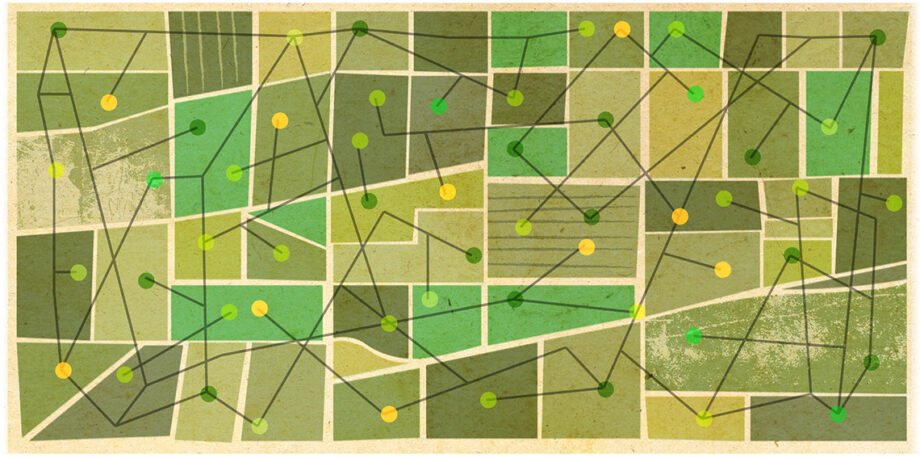November 23, 2015 — Editor’s note: This Voices piece is published in collaboration with the academic journal Elementa as part of its New Pathways to Sustainability in Agroecological Systems forum.
 If you live in the U.S., chances are you are among the 84 percent of American consumers who purchase organic food. Whether you buy it at the grocery store or the farmers market, you trust that food marketed as organic has been raised without toxic chemicals, using farming methods that are environmentally sustainable. At a minimum, you expect organic farmers to forgo the synthetic nitrogen fertilizer responsible for the dead zones in the Gulf of Mexico and much of the food system’s greenhouse gas footprint. You also expect they’ll avoid common herbicides associated with cancer risk and the development of herbicide-resistant superweeds. And, a bit more ambitiously, you expect organic farmers will take proactive steps to manage for soil health and biodiversity. But how do you know?
If you live in the U.S., chances are you are among the 84 percent of American consumers who purchase organic food. Whether you buy it at the grocery store or the farmers market, you trust that food marketed as organic has been raised without toxic chemicals, using farming methods that are environmentally sustainable. At a minimum, you expect organic farmers to forgo the synthetic nitrogen fertilizer responsible for the dead zones in the Gulf of Mexico and much of the food system’s greenhouse gas footprint. You also expect they’ll avoid common herbicides associated with cancer risk and the development of herbicide-resistant superweeds. And, a bit more ambitiously, you expect organic farmers will take proactive steps to manage for soil health and biodiversity. But how do you know?
As the organic sector has grown from its counterculture origins to a $39 billion industry, the audit and inspection process for organic foods has formalized. The definition of the word “organic” is now a matter of federal law, and any farmer or food company marketing its products as organic must keep careful records, submit to an annual inspection and refrain from using any chemicals not included on the approved list regularly updated by the Organic Materials Review Institute. This regulatory infrastructure has, rightly so, led consumers to trust the organic label.
However, equally or perhaps even more important than this regulatory structure are networks of peer review and technical assistance that serve as a source of both support and accountability for the nation’s growing population of organic farmers. This informal aspect of organic sector governance is largely invisible to consumers, but is critical to making sure the organic label lives up to its promise of environmental sustainability. To keep the organic sector honest — and robust — we need to support the farmer networks and farmer-directed research that constitute this informal layer of governance, by providing federal research and extension funding.
Over the past five years, I’ve been conducting research with a group of organic farmers in Montana who grow ancient grains that end up in organic cereal and organic lentils and chickpeas that fill natural food store bulk bins. I asked each of these farmers a straightforward question that turned out to have a complex answer: What supports you and holds you accountable in utilizing sustainable farming practices?
Since the group of people who grew and ate organic food was relatively small and tight knit, united by common ideals, there was little concern about cheating; organic certifiers were more like extension agents than conventional auditors.
These organic farmers cited multiple layers of support and accountability, and the most important thing I learned from them is that, from the farmer’s perspective, a wide variety of elements go into maintaining a successful, environmentally sound organic farm, from community support to public policy to green distribution businesses that connect conscientious consumers with farmers who are willing to go “beyond organic” with practices like pollinator-friendly vegetative borders and complex crop rotations. However, a particularly important insight was about the complementary but distinct roles of government-mandated organic audits and the non-mandated yet crucial self-governance of the organic community — or as some farmers called it, the “organic family.”
Organic’s Early Years
To understand the distinction between the formal organic certification process and the broader dynamics of the organic community, it’s helpful to roll the clock back to the 1980s. In these early years of the organic industry, no centralized standards existed: Individual certifiers such as California Certified Organic Farmers and Farm Verified Organic established their own processes for setting standards and verifying farmers were meeting them. Since the group of people who grew and ate organic food was relatively small and tight knit, united by common ideals, there was little concern about cheating; organic certifiers were more like extension agents (university-affiliated civil servants tasked with disseminating research-based farming advice) than conventional auditors. As the farmers I interviewed explained, organic certification at that time was essentially a peer review process through which farmers challenged and supported one another in improving their practices. As the industry expanded and consumers were less and less likely to have a personal connection with their farmers, demand grew for a common, federally mandated definition of organics, resulting in the establishment of the National Organic Program and the U.S. Department of Agriculture organic seal in 2000.
As I’ve found in my research, however, the federal organic law and its mandated audit process did not replace earlier, less formal methods of governing the organic sector. Rather, peer review and technical support networks have continued to develop alongside formal organic standards. Importantly, it’s these peer review and technical support networks that remain the fundamental driving force that both supports the expansion of the organic industry and keeps it true to its values.
A Responsibility to Each Other
A good example is the Farm Improvement Club program, which operated in Montana from 1990 to 2000, a time of rapid expansion in organic farming. Managed by the nonprofit Alternative Energy Resources Organization, this program was identified by many of the farmers I interviewed as the primary driver of organic conversions in the region and credited with dramatically increasing the prevalence of sustainable practices — even on noncertified farms.
Importantly, the program created a community of farmers who felt responsible to one another to uphold standards and who helped each other solve problems rather than settle for shortcuts.
The Farm Improvement Club model was simple: AERO offered grants of up to US$800 each to groups of four or more producers. Each group proposed a project to investigate a common interest or problem related to conserving resources and enhancing members’ operations. The Farm Improvement Clubs had to be farmer directed, but they also had to include a technical advisor from a university system or a government agency. This stipulation ostensibly provided farmers with access to expertise and resources, but also served to educate the clubs’ technical advisors about sustainable practices. The clubs gathered at the end of the year to share what they’d learned — and participating farmers frequently offered mid-season demonstrations as well. Over the course of a decade, AERO grants supported more than 120 clubs and 500 participating producers and technical assistance providers, and in 1994, the USDA gave the organization a US$91,000 grant to implement a training program across five states to teach its extension agents about sustainable agriculture.
As a thoroughly grassroots but institutionalized initiative, designed to connect local efforts to one another while better utilizing existing technical support infrastructure, the Farm Improvement Club program not only helped farms transition to organic, but also made sure they had staying power. Importantly, the program created a community of farmers who felt responsible to one another to uphold standards and who helped each other solve problems rather than settle for shortcuts. For many participants, the clubs’ standards of responsible farming preceded the federal definition of organic and even the organic movement as it is commonly understood, harking back to their grandparents’ participation in agrarian groups such as the Farmers Union, which promoted a fairer food system and a cooperative farm economy.
To be sure, regulation plays an important role in keeping organics honest — and could play an even larger role in improving the sustainability and fairness of the food system as a whole (given that the nonorganic segment of the food industry has fewer intrinsic incentives to pursue environmentally and socially responsible practices). But audits alone won’t uphold the organic sector. In my research, I’ve come to understand organics as what British political economist E.P. Thompson called a “moral economy”: “a popular consensus as to what are legitimate and what are illegitimate practices, grounded upon a consistent traditional view of social norms and obligations, of the proper economic functions of several parties within the community.” Because this form of community governance is what organic farmers themselves recognize as their primary source of both support and accountability, we should focus organic policy on nurturing networks of peer review and technical support — by publicly funding initiatives such as the Farm Improvement Club program — rather than simply adding to and refining formal audit procedures. ![]()
Editor’s note: The views expressed here are those of the author and not necessarily of Ensia. We present them to further discussion around important topics. We encourage you to respond with a comment below, following our commenting guidelines, which can be found here. In addition, you might consider submitting a Voices piece of your own. See Ensia’s “Contact” page for submission guidelines.
Ensia shares solutions-focused stories free of charge through our online magazine and partner media. That means audiences around the world have ready access to stories that can — and do — help them shape a better future. If you value our work, please show your support today.
Yes, I'll support Ensia!

There is no morality in how they operate around here. Organic farmers leave more of a carbon foot print than no till farmers. I feel bad for people who think they are buying organic, but really only paying more for the same conventional product. There are a few pure organics, but the bad far out weighs the good.